서브메뉴
본문내용
We use ceramics in our everyday lives. Ceramic vessels of every kind are now so common and so ubiquitous that most of us have little or no concept of them or their history and production techniques. Only when we understand properties of the material called clay, pottery making techniques, and the historical background of ceramics can we fully appreciate the true value of ceramics.
Ceramic Culture Hall opened on August 21, 2004 to help the public better understand and appreciate ceramics and artworks through the ages. It presents the concept, history, and production techniques of ceramics in a readily understandable way. All the materials and exhibits on display were selected and verified with the utmost care to tell the story of Korean ceramics as precisely and impactfully as possible. Visitors’ comfort was also duly taken into account in the layout of the exhibition space.
What is more, especial care was taken to make the exhibition panels visually interesting. Audio/visual media such as videos and panoramas, and hands-on equipment such as a microscope are fully utilized to make a visit here even more educational and enjoyable.

-
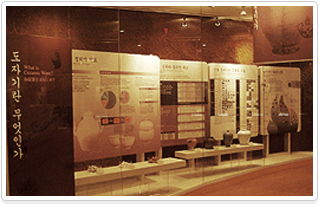
- The first tour in Ceramic Culture Hall is about the basic concept of ceramics.
Using panels and samples, this section explains the definition of ceramics, the composition of chemical components and the geological processes that produce clay and the materials for glaze, and the classification systems of the East and the West according to characteristics of ceramics. Also explained are the types of traditional Korean ceramics, and the classification of ceramics by function into dinner sets, kitchen utensils, ritual vessels, and industrial containers.
This section even explores the social function and role of ceramics as a representative new material invented by humankind.

-
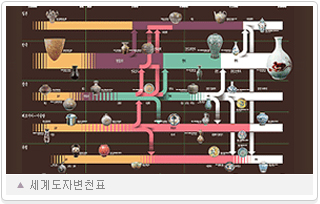
- In this corner, visitors can see the general flow of development and exchange of world ceramics from prehistoric to modern times.
The huge illustration on Development of World Ceramics shows how the porcelain of East Asia, where ash glaze had been developed, spread to the world, influencing the soft paste stoneware of Europe and West Asia and in turn being influenced by it.
In order to help visitors understand the nature of the influences chronologically and compare representative artifacts of each period, four monitors on the panel show the transition by period as follows:
1. Prehistoric Age (Birth of Civilization - Earthenware) 2. Ancient Times (High-temperature fired ash glazed stoneware/ Low-temperature fired lead glazed stoneware)
3. Middle Ages (Celadon of China and Korea/ Islamic stoneware with colored glaze)
4. Modern Age (Porcelain of China, Korea, and Japan/ Porcelain era in Europe)

-
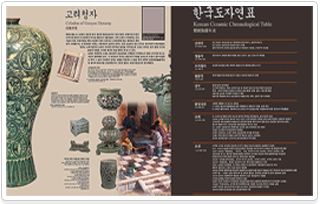
- This section explains the history of Korean ceramics, which has long led the ceramics of the world.
A chronological table shows the 8,000 year history of Korean ceramics at a glance. A series of panels shows the succession of pottery of the prehistoric age, earthenware of the Three Kingdoms and the Unified Silla, Goryeo celadon, buncheong, Joseon white porcelain, royal kilns and regional kilns, and international exchange of Joseon porcelain, helping visitors easily gain a general understanding of the history of Korean ceramics.
Also displayed here are some 150 shards of ceramics excavated from kiln sites to let visitors learn about ceramics by touching real objects.
Poems about ceramics composed by Yi Gyu-bo, a famed poet of Goryeo, and Bak Sang, a literatus of Joseon, are introduced to help visitors appreciate the beauty of Korean ceramics through literature.

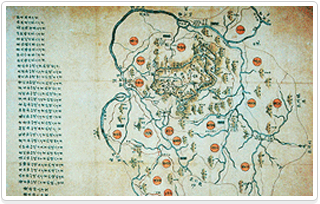
- In Gwangju, where the museum is located, are some 340 historic sites of royal kilns which produced ceramics for royal use.
The Gwangju royal kilns were overseen by Saongwon, the government agency that was responsible for the preparation of the King's meals. The royal kilns were the center of the ceramics of Joseon, and knowing about them is essential to truly understand the meaning of Joseon white porcelain.
Panels explaining in depth about concept of and background of construction of royal kilns, the organization of potters of royal kilns, the supply of firing wood and operation of the royal kilns, characteristics of porcelain produced at the royal kilns and ongoing studies on royal kiln sites, and display of artifacts excavated from eight kiln sites including Doma-ri, Gwaneum-ri, Seondong-ri, and Geumsa-ri, will help visitors better understand the royal kilns and Joseon white porcelain.

-
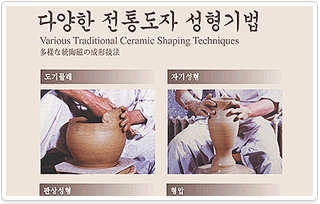
- The production process of white porcelain at the royal kilns is shown in chronological order. First, a large-scale diorama of a royal kiln of the 18th century and a video explain the organization of the white porcelain workplace and role of potters.
Then, eight stages of the production process -1) Collection of raw material clay, 2) Removal of impurities from clay and kneading, 3) Shaping 4) Throwing, 5) Bisque firing, 6) Decoration, 7) Glazing, 8) Glaze firing - and various techniques used to each stage are shown together with models and actual equipment, shards excavated from kiln sites, replicas, and minerals.
Also, the structure and development stages of traditional kilns and use of kiln equipment are explained to help visitors more easily understand the production environment of white porcelain.

-
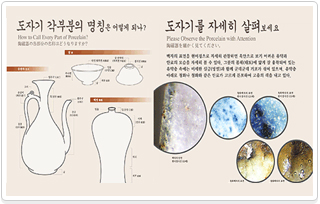
- This section gives some tips on how to look at ceramics. Through a microscope, visitors can observe the minutest details and color of glaze that cannot be seen with the naked eye.
By touching ceramics with hands, visitors can feel texture and weight.
The technical terms for each part of ceramics vessels and nomenclature of ceramics are explained.













 Ceramic Tour
Ceramic Tour































